| John Calvin Coolidge | |
|---|---|
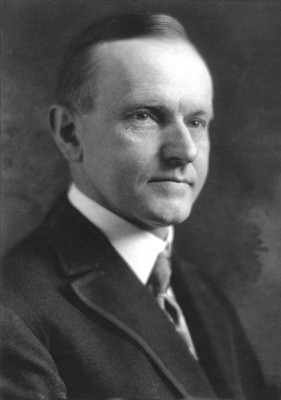 |
|
| 30th United States President « Previous Next » |
|
| In office | Aug. 2, 1923 – Mar. 4, 1929 |
| V. President | Charles Dawes |
| Political Party | Republican |
| Personal Info | |
| Born | July 4, 1872 |
| Died | Jan. 5, 1933 (at age 60) |
| Religion | Congregationalism |
| School | Amherst College |
| Profession | Lawyer |
| Signature | |
| Wife | Grace Goodhue |
| Children | John Coolidge Calvin Coolidge |
| U.S. Presidents 26-35 | |
| 26. Theodore Roosevelt (1901-1909) | |
| 27. William H. Taft (1909-1913) | |
| 28. Woodrow Wilson (1913-1921) | |
| 29. Warren G. Harding (1921-1923) | |
| 30. Calvin Coolidge (1923-1929) | |
| 31. Herbert Hoover (1929-1933) | |
| 32. Franklin D. Roosevelt (1933-1945) | |
| 33. Harry S. Truman (1945-1953) | |
| 34. Dwight D. Eisenhower (1953-1961) | |
| 35. John F. Kennedy (1961-1963) | |
| List of All the Presidents |
John Calvin Coolidge Jr. was the 30th President of the United States. A Republican lawyer, he gained political experience in Massachusetts by being the state governor. He had been known by his methods during the Boston Police Strike of the year 1919 before becoming the country’s twenty-ninth Vice President in 1920. He became President after the untimely death of Warren Harding in 1923. He was known to be a quiet conservative.
The Early Life of Calvin Coolidge
Coolidge was born the elder of two children in Plymouth Notch, Windsor Country in Vermont on the 4th of July 1872. He was the only president to have been born on Independence Day. When he was still twelve years old his mother, Victoria Josephine Moor, who was a daughter of a farmer, passed away, possibly from tuberculosis. His sister, Abigail Grace Coolidge, died as well at the age of fifteen, five years later. His father, John Coolidge, Sr. remarried a schoolteacher in 1891. Coolidge Sr. had taken many jobs before becoming rising to fame in the entire state as a trusted farmer and storekeeper. While farming, he also taught in school, managed his store, and served in the House of Representatives of Vermont and the Vermont Senate as well. He also became justice of the peace and a tax collector. He lived with his son until the age of eighty.
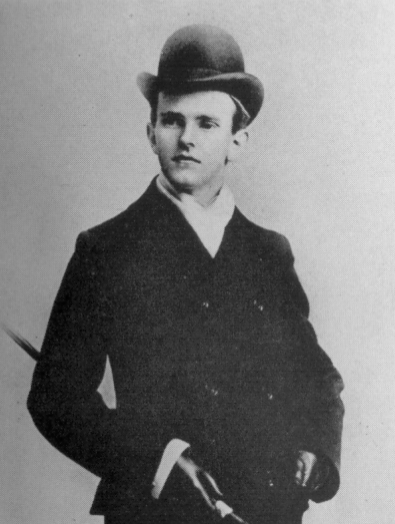 Coolidge had first studied in Black River Academy before moving on to Amherst College. There, he joined a fraternity known as Phi Gamma Delta. After graduating, his father soon urged him to relocate to Northampton in Massachusetts to take up law. In order to save the hassle of spending large amounts of money in a law school, he decided to become an apprentice and law reader in Hammond & Field, a local law firm. He gained entry to the bar and became a country lawyer. In 1898 he was able to open his own office with the help of his measly savings and an inheritance from his deceased grandfather. He found it best to stay out of court while attending to his clients, practicing transactional law. Soon his reputation started to grow as local banks and other business ventures began seeking his services.
Coolidge had first studied in Black River Academy before moving on to Amherst College. There, he joined a fraternity known as Phi Gamma Delta. After graduating, his father soon urged him to relocate to Northampton in Massachusetts to take up law. In order to save the hassle of spending large amounts of money in a law school, he decided to become an apprentice and law reader in Hammond & Field, a local law firm. He gained entry to the bar and became a country lawyer. In 1898 he was able to open his own office with the help of his measly savings and an inheritance from his deceased grandfather. He found it best to stay out of court while attending to his clients, practicing transactional law. Soon his reputation started to grow as local banks and other business ventures began seeking his services.
Calvin Coolidge met Grace Anna Goodhue, a teacher from Clarke School for the Deaf. She was also from Vermont. In 1903, she got her first look at Coolidge after looking up the window of a boarding house and saw him shaving wearing nothing but his underwear and his hat. They always considered themselves opposites in terms of attitude; Grace was known to be outgoing while Coolidge was known to be more of the serious type. On October 4, 1905, after two years of becoming acquainted with each other, they finally married in Grace’s parents’ home in Burlington. Grace bore their first son, John, in 1906, and Calvin, Jr. in 1908. Most biographies describe Coolidge’s married life as a happy one. Grace, with her talkativeness, also played a key part in Coolidge’s presidency, serving as a sort of cushion between her husband and the public.
Coolidge as Vice President
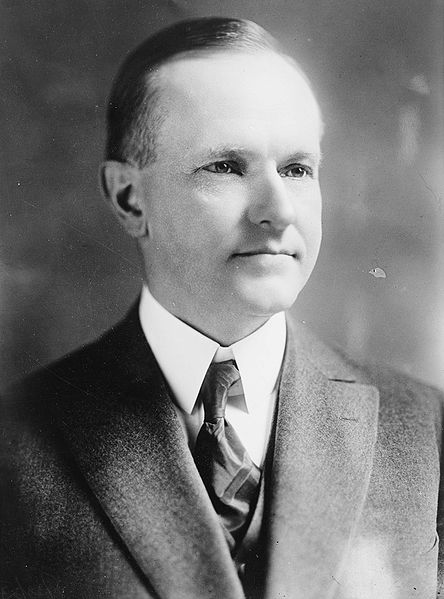 Coolidge became Vice President in the year 1921. As a candidate he placed only as high as sixth in the ballots. Ten ballots later, the Republicans selected Senator Warren G. Harding as Presidential nominee. The party then considered Senator Irvine Lenroot from Winsonsin as their Vice Presidential nominee, but soon decided to settle on Coolidge after a delegate from Oregon read his speech entitled Have Faith in Massachusetts while he was still in the State Senate. The nomination had been unexpected, with the Democrats nominating James M. Coz from Ohio as President and Franklin D. Roosevelt for Vice President. Coolidge and Harding both won in a landslide on November 20, 1920, winning all states outside the South, along with Tennessee.
Coolidge became Vice President in the year 1921. As a candidate he placed only as high as sixth in the ballots. Ten ballots later, the Republicans selected Senator Warren G. Harding as Presidential nominee. The party then considered Senator Irvine Lenroot from Winsonsin as their Vice Presidential nominee, but soon decided to settle on Coolidge after a delegate from Oregon read his speech entitled Have Faith in Massachusetts while he was still in the State Senate. The nomination had been unexpected, with the Democrats nominating James M. Coz from Ohio as President and Franklin D. Roosevelt for Vice President. Coolidge and Harding both won in a landslide on November 20, 1920, winning all states outside the South, along with Tennessee.
As Vice President, Coolidge was invited to many cabinet meetings, becoming the first man in the position to gain such privilege. He and his wife Grace were invited to a number of events, allowing him to give speeches. He was known, however, as a quiet and private person, gaining him the nickname “Silent Cal.” A famous poet, Dorothy Parker, reportedly joked upon Coolidge’s death by asking, “How can they tell?” When asked for the reason why he was so quiet yet he still attended all those gatherings, Coolidge replied in his usual seriousness, “Got to eat somewhere.” His reputation as a quiet and serious man spread throughout the country, with some scholars debating whether it is a campaign tactic or is truly his personality. Nevertheless, Coolidge’s mysterious demeanor continued until he became President in 1923.
Calvin Coolidge Presidency
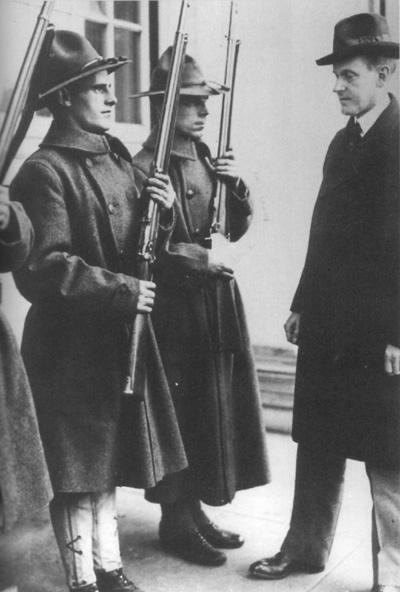 President Harding died in California on August 2, 1923. Coolidge was in his Vermont home during that time with his father when he received news of this untimely death. It was reported that he dressed, prayed and greeted the reporters outside his house. Calvin Coolidge, Sr., a notary public, gave him the oath of office using their family Bible. The oath-taking took place by their kerosene lamp on August 23, 1923, three hours before sunrise. He was re-sworn to position by Justice Hoehling, Jr. when he returned to Washington after finding out that a mere notary public had done the duty.
President Harding died in California on August 2, 1923. Coolidge was in his Vermont home during that time with his father when he received news of this untimely death. It was reported that he dressed, prayed and greeted the reporters outside his house. Calvin Coolidge, Sr., a notary public, gave him the oath of office using their family Bible. The oath-taking took place by their kerosene lamp on August 23, 1923, three hours before sunrise. He was re-sworn to position by Justice Hoehling, Jr. when he returned to Washington after finding out that a mere notary public had done the duty.
The United States was at first hesitant to acknowledge a quiet man as president, for the man had not quite stood out on his previous position as vice president. Coolidge inherited a presidency that was filled with scandal and corruption, and he swore to fix these and restore the public’s trust in the administration. A big surprise came when he decided not to force the previous people of the administration to resign. He gave a speech addressing Harding’s previous governance, and that it was his duty to continue what the former president had started. It was the first speech of an American president to be broadcasted in a radio.
After ending Harding’s term, the Republicans re-nominated Coolidge on their first ballot, which he declined. On the third ballot given by Charles G. Dawes, however, he accepted. The Democrats, on the other hand, agreed upon John W. Davis with Charles W. Bryan as Vice President. Shortly after the nominations happened, Coolidge’s son, Calvin, developed sepsis after developing a blister while playing tennis in the White House. He died shortly. In spite of this devastating event, Coolidge still pushed through with the run for presidency, avoiding the pitfalls of badmouthing opponents or mentioning his son’s name for pity votes. The time was known to be a very solemn campaign, with every one aware of his son’s death. Coolidge and Dawes won all non-South states, except Wisconsin.
As president, Coolidge tried his best to control the stock market. During that era, the United States had been undergoing the Roaring Twenties, or the period of economic growth. Taxes during that time were greatly reduced after being filed by his Secretary of Treasury Andrew Mellon. The new tax code enable only a select people to pay the taxes, and Coolidge gave reductions to federal debt. Even the Republicans in the Congress agreed to these views. The most well-known contribution of Coolidge’s presidency was the farm subsidies that fought the aggravating prices of agriculture. Other actions worth noting were his methods of flood control during the Great Mississippi Flood of 1927. He, however, failed to control the stock market in the end, which resulted in its crash on October 1929.
Life After Presidency
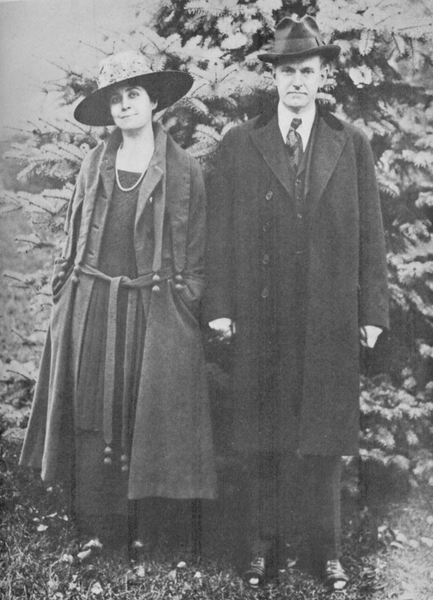 After his term Calvin Coolidge decided not to run for president again. He delivered his iconic decline in South Dakota, Black Hills. During that time he had been known as a man who, although reserved to the public, had a strange habit of letting people take pictures of him wearing costumes. He returned to his house, known as “The Beeches,” in Northampton in the year 1929. He opted to buy a larger house after he got tired of seeing strangers drive around his estate.
After his term Calvin Coolidge decided not to run for president again. He delivered his iconic decline in South Dakota, Black Hills. During that time he had been known as a man who, although reserved to the public, had a strange habit of letting people take pictures of him wearing costumes. He returned to his house, known as “The Beeches,” in Northampton in the year 1929. He opted to buy a larger house after he got tired of seeing strangers drive around his estate.
History had not been quite kind to Coolidge, though. Scholars say it is difficult to pinpoint any specific legislation that came during his rule. Others go as far as saying that his real measure of success as president was his way of doing absolutely nothing at all. In 1929, he published an autobiography and from 1930 to 1931 wrote in his own newspaper column entitled “Calvin Coolidge Says.”
Coolidge suddenly suffered a heart attack at his home forty-five minutes after noon on the 5th of January, 1933. He died immediately. It is reported that shortly before he passed away, he told an old friend of his that he feels that he could not fit in with the times anymore. His body is buried underneath a simple headstone in the North Cemetery of Plymouth Notch in Vermont, the place where his ancestral home had stood. The state dedicated a center for new visitors to mark his hundredth birthday on the 4th of July, 1972. In the Hall of Inscriptions inside the Vermont State House, his Brave Little State of Vermont speech is inscribed.